Case Study on Congestive Heart Failure
VerifiedAdded on 2023/06/14
|14
|3620
|51
AI Summary
Read this case study on congestive heart failure and learn about its causes, incidence, risk factors, impact, signs and symptoms, pathophysiology, medication administration, and more.
Contribute Materials
Your contribution can guide someone’s learning journey. Share your
documents today.
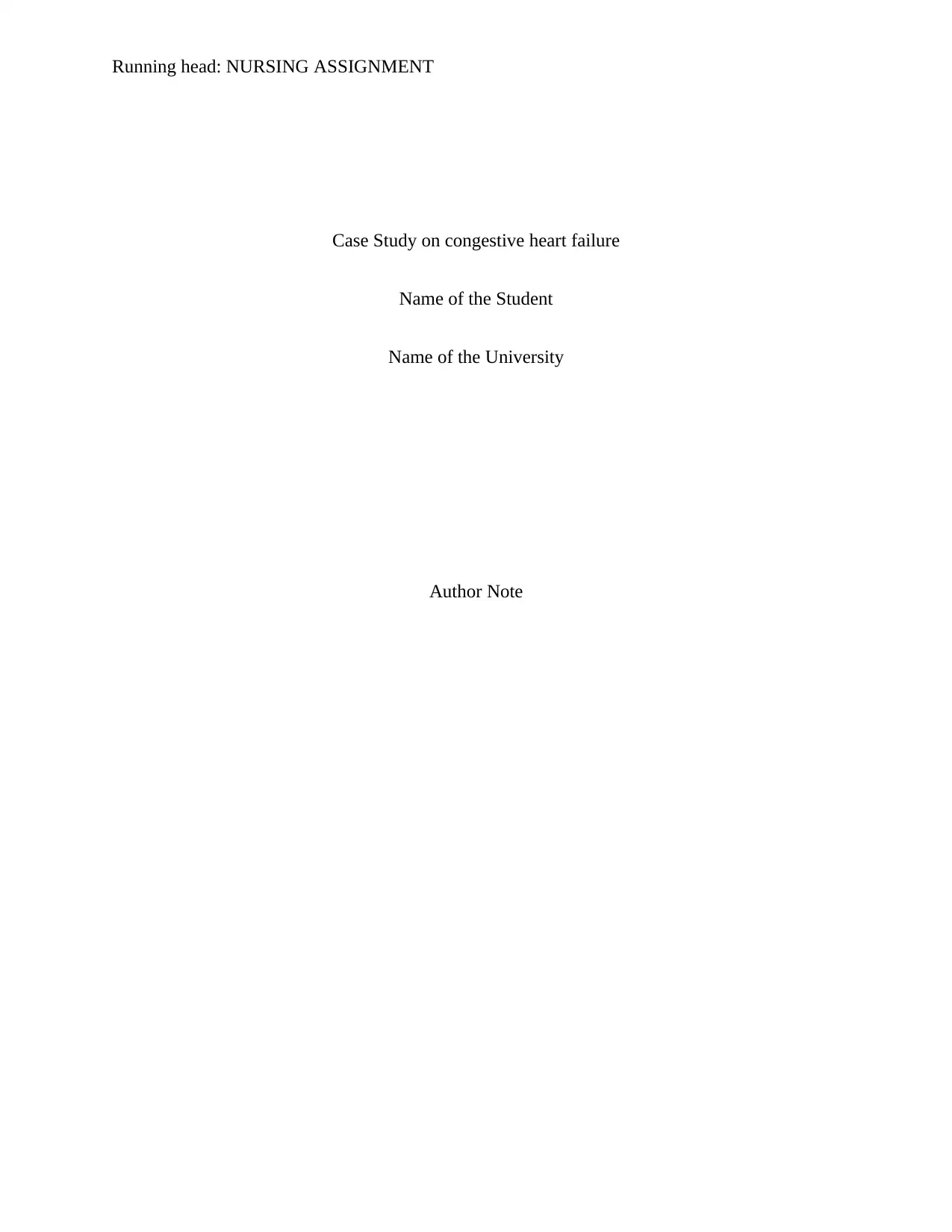
Running head: NURSING ASSIGNMENT
Case Study on congestive heart failure
Name of the Student
Name of the University
Author Note
Case Study on congestive heart failure
Name of the Student
Name of the University
Author Note
Secure Best Marks with AI Grader
Need help grading? Try our AI Grader for instant feedback on your assignments.
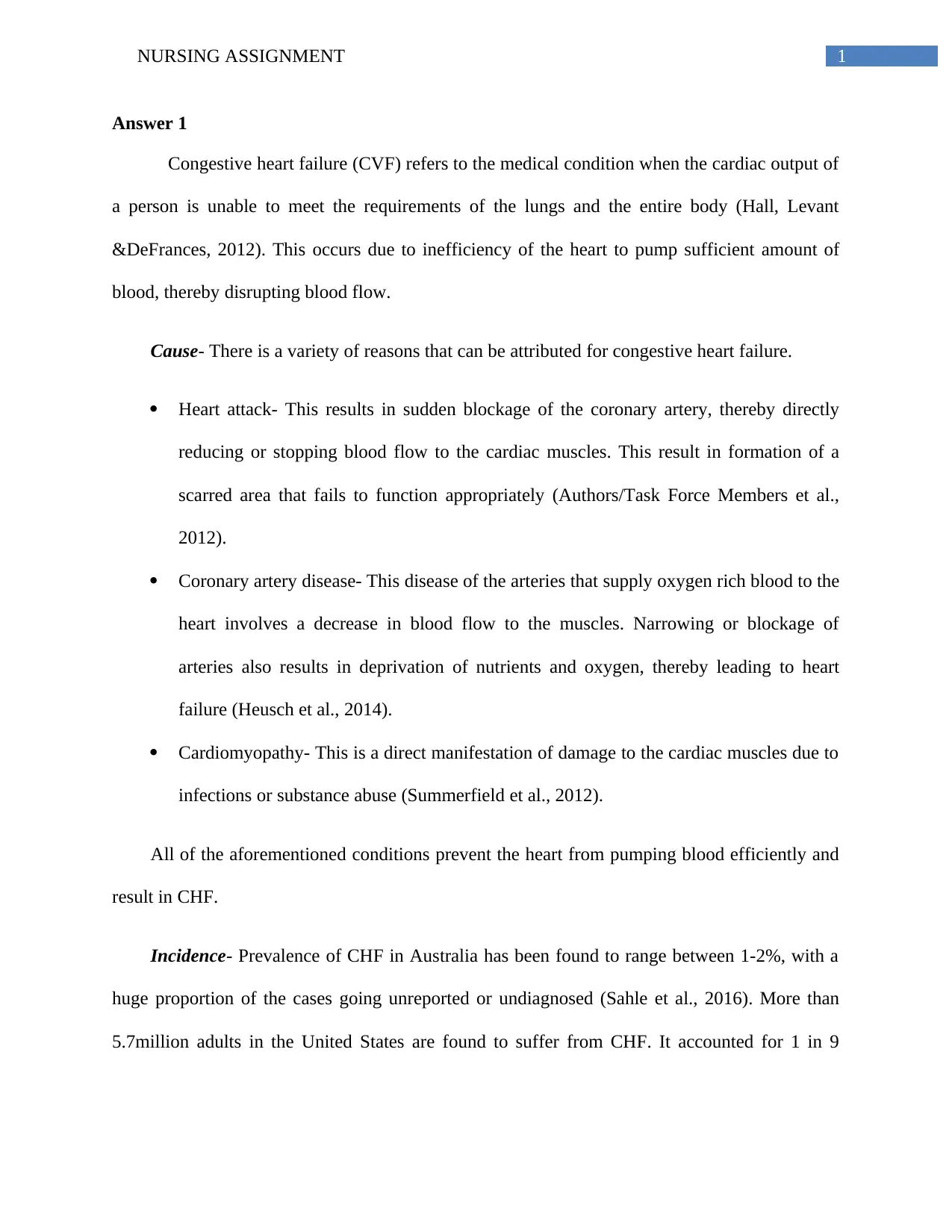
1NURSING ASSIGNMENT
Answer 1
Congestive heart failure (CVF) refers to the medical condition when the cardiac output of
a person is unable to meet the requirements of the lungs and the entire body (Hall, Levant
&DeFrances, 2012). This occurs due to inefficiency of the heart to pump sufficient amount of
blood, thereby disrupting blood flow.
Cause- There is a variety of reasons that can be attributed for congestive heart failure.
Heart attack- This results in sudden blockage of the coronary artery, thereby directly
reducing or stopping blood flow to the cardiac muscles. This result in formation of a
scarred area that fails to function appropriately (Authors/Task Force Members et al.,
2012).
Coronary artery disease- This disease of the arteries that supply oxygen rich blood to the
heart involves a decrease in blood flow to the muscles. Narrowing or blockage of
arteries also results in deprivation of nutrients and oxygen, thereby leading to heart
failure (Heusch et al., 2014).
Cardiomyopathy- This is a direct manifestation of damage to the cardiac muscles due to
infections or substance abuse (Summerfield et al., 2012).
All of the aforementioned conditions prevent the heart from pumping blood efficiently and
result in CHF.
Incidence- Prevalence of CHF in Australia has been found to range between 1-2%, with a
huge proportion of the cases going unreported or undiagnosed (Sahle et al., 2016). More than
5.7million adults in the United States are found to suffer from CHF. It accounted for 1 in 9
Answer 1
Congestive heart failure (CVF) refers to the medical condition when the cardiac output of
a person is unable to meet the requirements of the lungs and the entire body (Hall, Levant
&DeFrances, 2012). This occurs due to inefficiency of the heart to pump sufficient amount of
blood, thereby disrupting blood flow.
Cause- There is a variety of reasons that can be attributed for congestive heart failure.
Heart attack- This results in sudden blockage of the coronary artery, thereby directly
reducing or stopping blood flow to the cardiac muscles. This result in formation of a
scarred area that fails to function appropriately (Authors/Task Force Members et al.,
2012).
Coronary artery disease- This disease of the arteries that supply oxygen rich blood to the
heart involves a decrease in blood flow to the muscles. Narrowing or blockage of
arteries also results in deprivation of nutrients and oxygen, thereby leading to heart
failure (Heusch et al., 2014).
Cardiomyopathy- This is a direct manifestation of damage to the cardiac muscles due to
infections or substance abuse (Summerfield et al., 2012).
All of the aforementioned conditions prevent the heart from pumping blood efficiently and
result in CHF.
Incidence- Prevalence of CHF in Australia has been found to range between 1-2%, with a
huge proportion of the cases going unreported or undiagnosed (Sahle et al., 2016). More than
5.7million adults in the United States are found to suffer from CHF. It accounted for 1 in 9
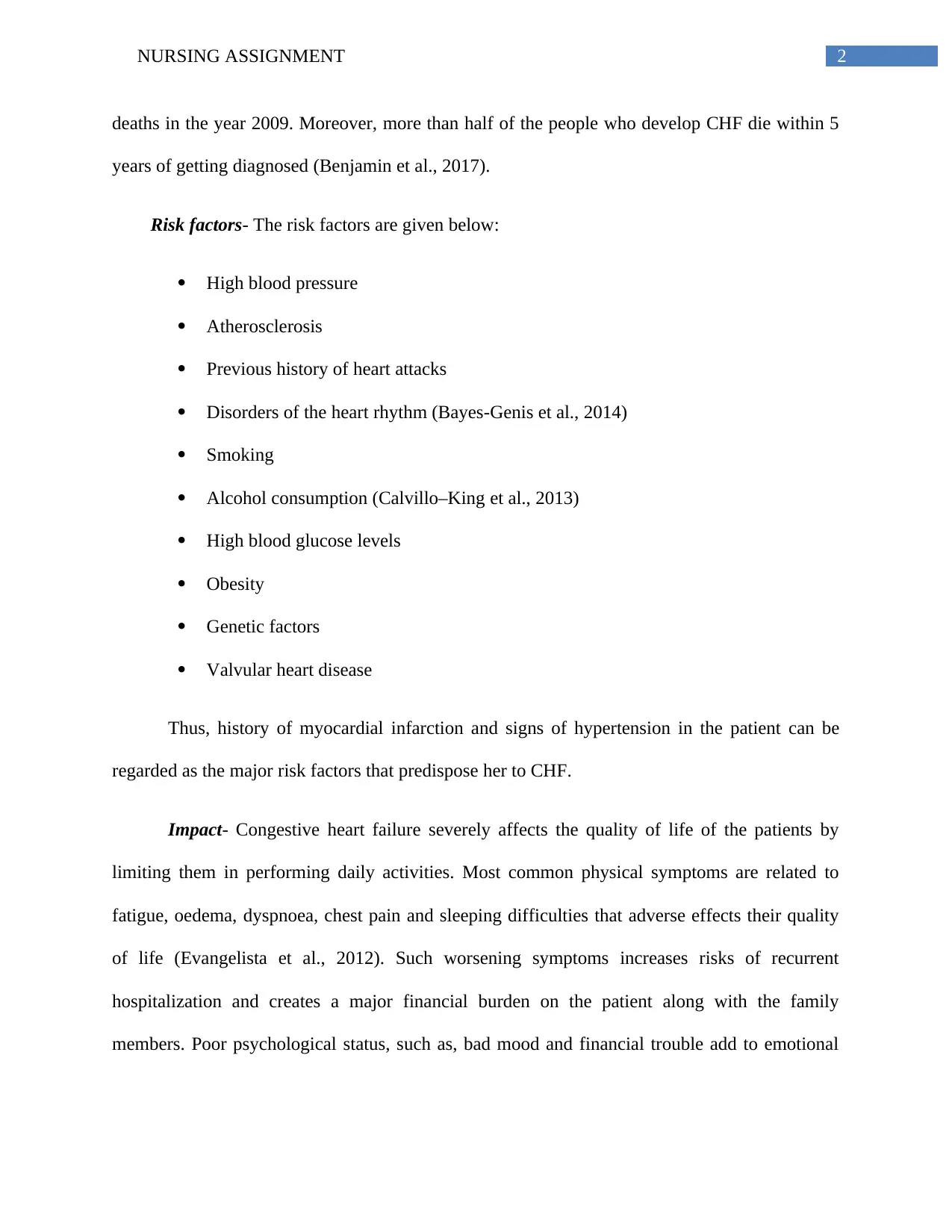
2NURSING ASSIGNMENT
deaths in the year 2009. Moreover, more than half of the people who develop CHF die within 5
years of getting diagnosed (Benjamin et al., 2017).
Risk factors- The risk factors are given below:
High blood pressure
Atherosclerosis
Previous history of heart attacks
Disorders of the heart rhythm (Bayes-Genis et al., 2014)
Smoking
Alcohol consumption (Calvillo–King et al., 2013)
High blood glucose levels
Obesity
Genetic factors
Valvular heart disease
Thus, history of myocardial infarction and signs of hypertension in the patient can be
regarded as the major risk factors that predispose her to CHF.
Impact- Congestive heart failure severely affects the quality of life of the patients by
limiting them in performing daily activities. Most common physical symptoms are related to
fatigue, oedema, dyspnoea, chest pain and sleeping difficulties that adverse effects their quality
of life (Evangelista et al., 2012). Such worsening symptoms increases risks of recurrent
hospitalization and creates a major financial burden on the patient along with the family
members. Poor psychological status, such as, bad mood and financial trouble add to emotional
deaths in the year 2009. Moreover, more than half of the people who develop CHF die within 5
years of getting diagnosed (Benjamin et al., 2017).
Risk factors- The risk factors are given below:
High blood pressure
Atherosclerosis
Previous history of heart attacks
Disorders of the heart rhythm (Bayes-Genis et al., 2014)
Smoking
Alcohol consumption (Calvillo–King et al., 2013)
High blood glucose levels
Obesity
Genetic factors
Valvular heart disease
Thus, history of myocardial infarction and signs of hypertension in the patient can be
regarded as the major risk factors that predispose her to CHF.
Impact- Congestive heart failure severely affects the quality of life of the patients by
limiting them in performing daily activities. Most common physical symptoms are related to
fatigue, oedema, dyspnoea, chest pain and sleeping difficulties that adverse effects their quality
of life (Evangelista et al., 2012). Such worsening symptoms increases risks of recurrent
hospitalization and creates a major financial burden on the patient along with the family
members. Poor psychological status, such as, bad mood and financial trouble add to emotional
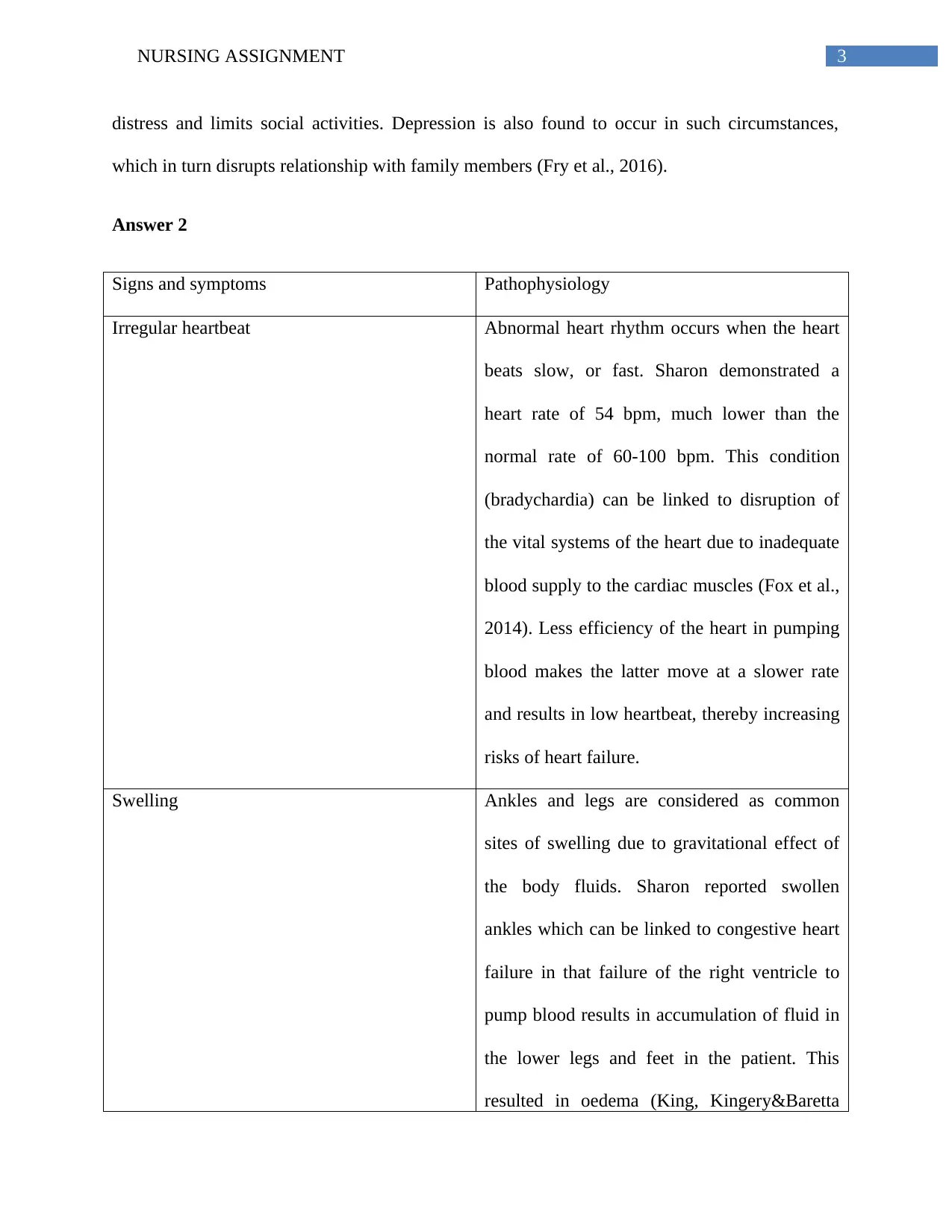
3NURSING ASSIGNMENT
distress and limits social activities. Depression is also found to occur in such circumstances,
which in turn disrupts relationship with family members (Fry et al., 2016).
Answer 2
Signs and symptoms Pathophysiology
Irregular heartbeat Abnormal heart rhythm occurs when the heart
beats slow, or fast. Sharon demonstrated a
heart rate of 54 bpm, much lower than the
normal rate of 60-100 bpm. This condition
(bradychardia) can be linked to disruption of
the vital systems of the heart due to inadequate
blood supply to the cardiac muscles (Fox et al.,
2014). Less efficiency of the heart in pumping
blood makes the latter move at a slower rate
and results in low heartbeat, thereby increasing
risks of heart failure.
Swelling Ankles and legs are considered as common
sites of swelling due to gravitational effect of
the body fluids. Sharon reported swollen
ankles which can be linked to congestive heart
failure in that failure of the right ventricle to
pump blood results in accumulation of fluid in
the lower legs and feet in the patient. This
resulted in oedema (King, Kingery&Baretta
distress and limits social activities. Depression is also found to occur in such circumstances,
which in turn disrupts relationship with family members (Fry et al., 2016).
Answer 2
Signs and symptoms Pathophysiology
Irregular heartbeat Abnormal heart rhythm occurs when the heart
beats slow, or fast. Sharon demonstrated a
heart rate of 54 bpm, much lower than the
normal rate of 60-100 bpm. This condition
(bradychardia) can be linked to disruption of
the vital systems of the heart due to inadequate
blood supply to the cardiac muscles (Fox et al.,
2014). Less efficiency of the heart in pumping
blood makes the latter move at a slower rate
and results in low heartbeat, thereby increasing
risks of heart failure.
Swelling Ankles and legs are considered as common
sites of swelling due to gravitational effect of
the body fluids. Sharon reported swollen
ankles which can be linked to congestive heart
failure in that failure of the right ventricle to
pump blood results in accumulation of fluid in
the lower legs and feet in the patient. This
resulted in oedema (King, Kingery&Baretta
Secure Best Marks with AI Grader
Need help grading? Try our AI Grader for instant feedback on your assignments.
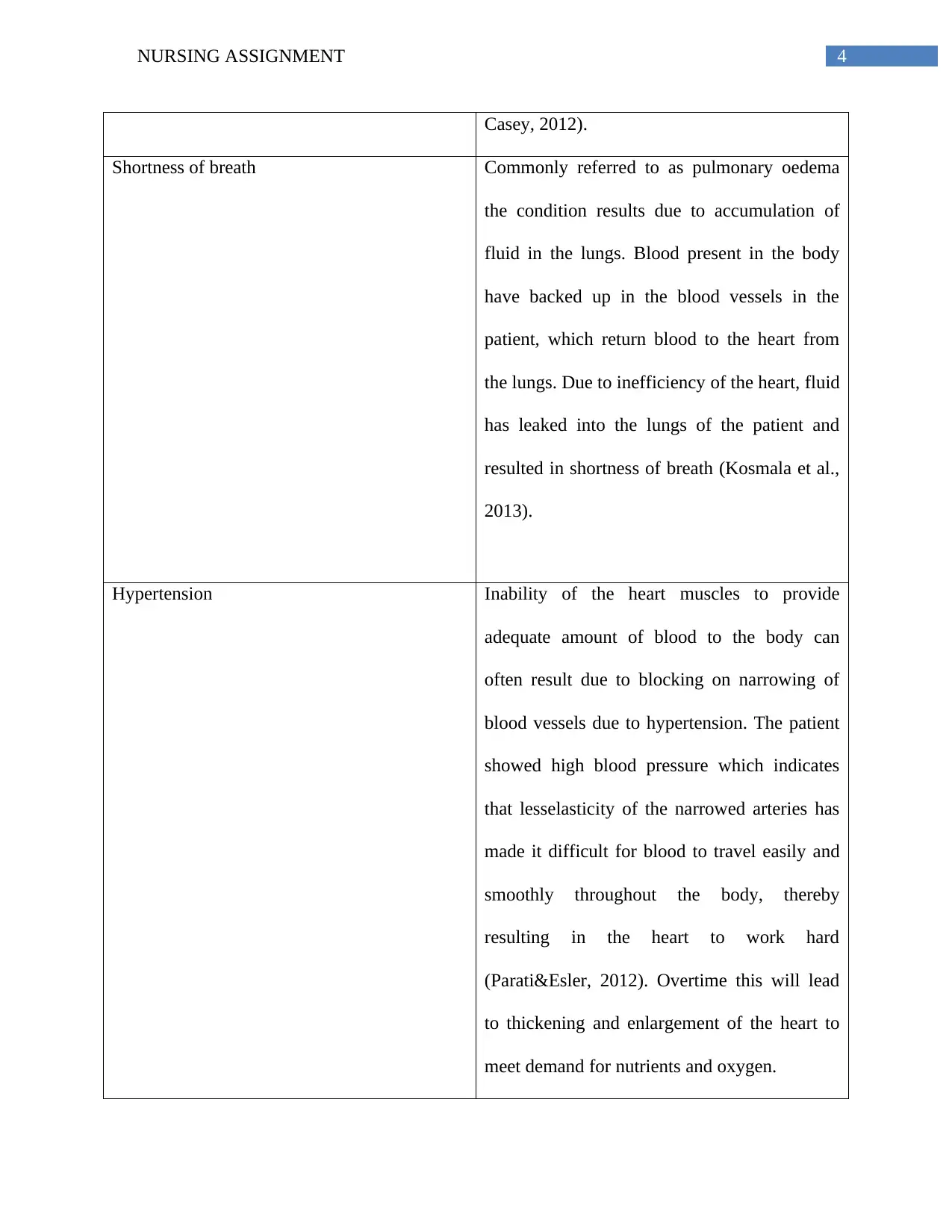
4NURSING ASSIGNMENT
Casey, 2012).
Shortness of breath Commonly referred to as pulmonary oedema
the condition results due to accumulation of
fluid in the lungs. Blood present in the body
have backed up in the blood vessels in the
patient, which return blood to the heart from
the lungs. Due to inefficiency of the heart, fluid
has leaked into the lungs of the patient and
resulted in shortness of breath (Kosmala et al.,
2013).
Hypertension Inability of the heart muscles to provide
adequate amount of blood to the body can
often result due to blocking on narrowing of
blood vessels due to hypertension. The patient
showed high blood pressure which indicates
that lesselasticity of the narrowed arteries has
made it difficult for blood to travel easily and
smoothly throughout the body, thereby
resulting in the heart to work hard
(Parati&Esler, 2012). Overtime this will lead
to thickening and enlargement of the heart to
meet demand for nutrients and oxygen.
Casey, 2012).
Shortness of breath Commonly referred to as pulmonary oedema
the condition results due to accumulation of
fluid in the lungs. Blood present in the body
have backed up in the blood vessels in the
patient, which return blood to the heart from
the lungs. Due to inefficiency of the heart, fluid
has leaked into the lungs of the patient and
resulted in shortness of breath (Kosmala et al.,
2013).
Hypertension Inability of the heart muscles to provide
adequate amount of blood to the body can
often result due to blocking on narrowing of
blood vessels due to hypertension. The patient
showed high blood pressure which indicates
that lesselasticity of the narrowed arteries has
made it difficult for blood to travel easily and
smoothly throughout the body, thereby
resulting in the heart to work hard
(Parati&Esler, 2012). Overtime this will lead
to thickening and enlargement of the heart to
meet demand for nutrients and oxygen.
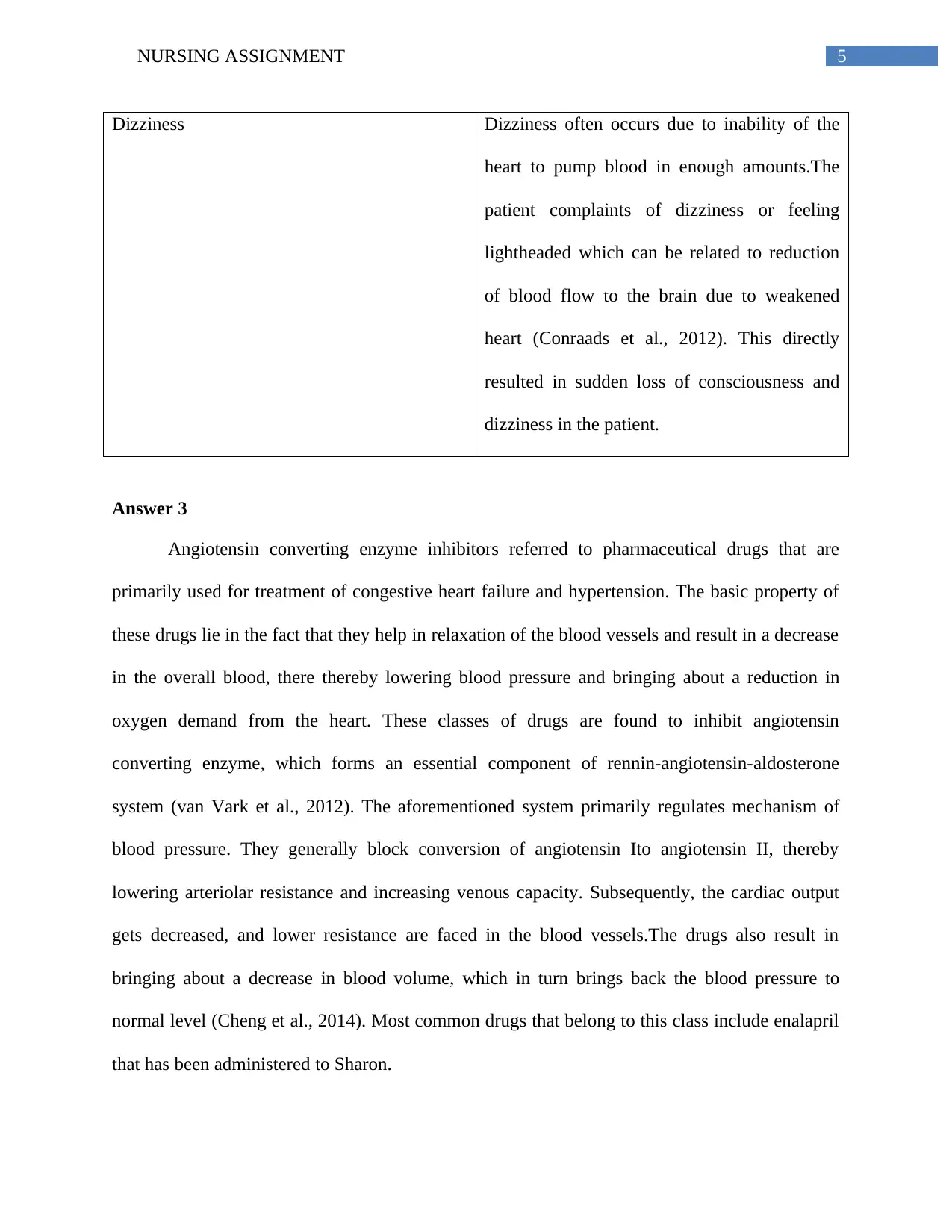
5NURSING ASSIGNMENT
Dizziness Dizziness often occurs due to inability of the
heart to pump blood in enough amounts.The
patient complaints of dizziness or feeling
lightheaded which can be related to reduction
of blood flow to the brain due to weakened
heart (Conraads et al., 2012). This directly
resulted in sudden loss of consciousness and
dizziness in the patient.
Answer 3
Angiotensin converting enzyme inhibitors referred to pharmaceutical drugs that are
primarily used for treatment of congestive heart failure and hypertension. The basic property of
these drugs lie in the fact that they help in relaxation of the blood vessels and result in a decrease
in the overall blood, there thereby lowering blood pressure and bringing about a reduction in
oxygen demand from the heart. These classes of drugs are found to inhibit angiotensin
converting enzyme, which forms an essential component of rennin-angiotensin-aldosterone
system (van Vark et al., 2012). The aforementioned system primarily regulates mechanism of
blood pressure. They generally block conversion of angiotensin Ito angiotensin II, thereby
lowering arteriolar resistance and increasing venous capacity. Subsequently, the cardiac output
gets decreased, and lower resistance are faced in the blood vessels.The drugs also result in
bringing about a decrease in blood volume, which in turn brings back the blood pressure to
normal level (Cheng et al., 2014). Most common drugs that belong to this class include enalapril
that has been administered to Sharon.
Dizziness Dizziness often occurs due to inability of the
heart to pump blood in enough amounts.The
patient complaints of dizziness or feeling
lightheaded which can be related to reduction
of blood flow to the brain due to weakened
heart (Conraads et al., 2012). This directly
resulted in sudden loss of consciousness and
dizziness in the patient.
Answer 3
Angiotensin converting enzyme inhibitors referred to pharmaceutical drugs that are
primarily used for treatment of congestive heart failure and hypertension. The basic property of
these drugs lie in the fact that they help in relaxation of the blood vessels and result in a decrease
in the overall blood, there thereby lowering blood pressure and bringing about a reduction in
oxygen demand from the heart. These classes of drugs are found to inhibit angiotensin
converting enzyme, which forms an essential component of rennin-angiotensin-aldosterone
system (van Vark et al., 2012). The aforementioned system primarily regulates mechanism of
blood pressure. They generally block conversion of angiotensin Ito angiotensin II, thereby
lowering arteriolar resistance and increasing venous capacity. Subsequently, the cardiac output
gets decreased, and lower resistance are faced in the blood vessels.The drugs also result in
bringing about a decrease in blood volume, which in turn brings back the blood pressure to
normal level (Cheng et al., 2014). Most common drugs that belong to this class include enalapril
that has been administered to Sharon.
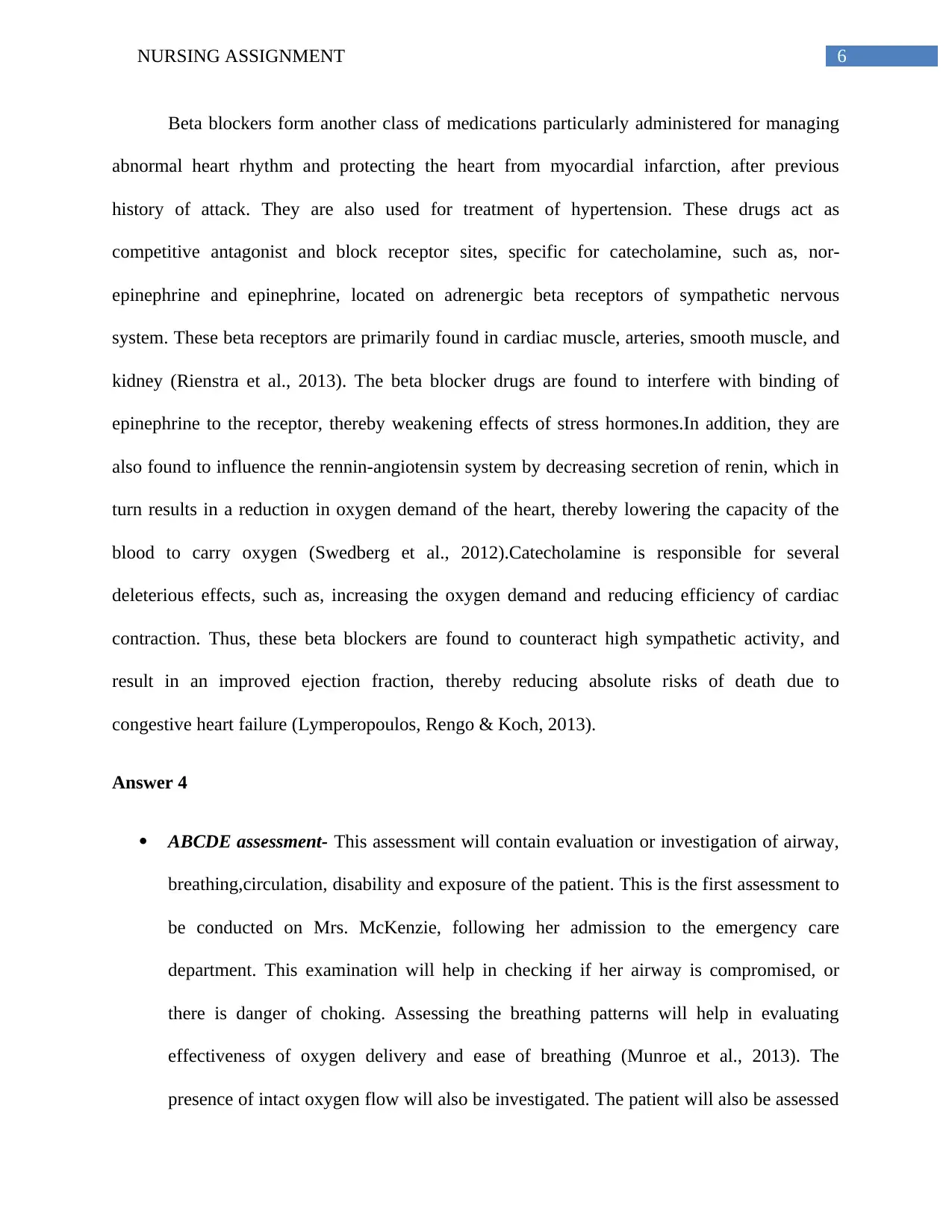
6NURSING ASSIGNMENT
Beta blockers form another class of medications particularly administered for managing
abnormal heart rhythm and protecting the heart from myocardial infarction, after previous
history of attack. They are also used for treatment of hypertension. These drugs act as
competitive antagonist and block receptor sites, specific for catecholamine, such as, nor-
epinephrine and epinephrine, located on adrenergic beta receptors of sympathetic nervous
system. These beta receptors are primarily found in cardiac muscle, arteries, smooth muscle, and
kidney (Rienstra et al., 2013). The beta blocker drugs are found to interfere with binding of
epinephrine to the receptor, thereby weakening effects of stress hormones.In addition, they are
also found to influence the rennin-angiotensin system by decreasing secretion of renin, which in
turn results in a reduction in oxygen demand of the heart, thereby lowering the capacity of the
blood to carry oxygen (Swedberg et al., 2012).Catecholamine is responsible for several
deleterious effects, such as, increasing the oxygen demand and reducing efficiency of cardiac
contraction. Thus, these beta blockers are found to counteract high sympathetic activity, and
result in an improved ejection fraction, thereby reducing absolute risks of death due to
congestive heart failure (Lymperopoulos, Rengo & Koch, 2013).
Answer 4
ABCDE assessment- This assessment will contain evaluation or investigation of airway,
breathing,circulation, disability and exposure of the patient. This is the first assessment to
be conducted on Mrs. McKenzie, following her admission to the emergency care
department. This examination will help in checking if her airway is compromised, or
there is danger of choking. Assessing the breathing patterns will help in evaluating
effectiveness of oxygen delivery and ease of breathing (Munroe et al., 2013). The
presence of intact oxygen flow will also be investigated. The patient will also be assessed
Beta blockers form another class of medications particularly administered for managing
abnormal heart rhythm and protecting the heart from myocardial infarction, after previous
history of attack. They are also used for treatment of hypertension. These drugs act as
competitive antagonist and block receptor sites, specific for catecholamine, such as, nor-
epinephrine and epinephrine, located on adrenergic beta receptors of sympathetic nervous
system. These beta receptors are primarily found in cardiac muscle, arteries, smooth muscle, and
kidney (Rienstra et al., 2013). The beta blocker drugs are found to interfere with binding of
epinephrine to the receptor, thereby weakening effects of stress hormones.In addition, they are
also found to influence the rennin-angiotensin system by decreasing secretion of renin, which in
turn results in a reduction in oxygen demand of the heart, thereby lowering the capacity of the
blood to carry oxygen (Swedberg et al., 2012).Catecholamine is responsible for several
deleterious effects, such as, increasing the oxygen demand and reducing efficiency of cardiac
contraction. Thus, these beta blockers are found to counteract high sympathetic activity, and
result in an improved ejection fraction, thereby reducing absolute risks of death due to
congestive heart failure (Lymperopoulos, Rengo & Koch, 2013).
Answer 4
ABCDE assessment- This assessment will contain evaluation or investigation of airway,
breathing,circulation, disability and exposure of the patient. This is the first assessment to
be conducted on Mrs. McKenzie, following her admission to the emergency care
department. This examination will help in checking if her airway is compromised, or
there is danger of choking. Assessing the breathing patterns will help in evaluating
effectiveness of oxygen delivery and ease of breathing (Munroe et al., 2013). The
presence of intact oxygen flow will also be investigated. The patient will also be assessed
Paraphrase This Document
Need a fresh take? Get an instant paraphrase of this document with our AI Paraphraser

7NURSING ASSIGNMENT
for presence of radial pulse, moisture, skin colour, and temperature. The level of
consciousness will determine if she is drowsy, restless, disoriented, unconscious, or
agitated.
Monitoring vital signs of the patient- Low cardiac output is found to affect the vital
signs adversely. The pulse rate likely to be high that acts as a compensatory mechanism
to hypoxia and low cardiac output. Disproportionately elevated blood pressure levels will
also indicate circulatory congestion that can be associated to poor venous return by the
heart. Shallow respiration due to lack of energy and low body temperature metabolism
and likely to be seen (Feltner et al., 2014). Hence, it is essential to monitor them and note
any likely abnormal changes.
Head-to-toe assessment- Head to toe assessment will encompass all the body systems
and the observations will help in providing a clear information on the overall condition of
the patient (Uchida et al., 2014).
Focused assessment – Focused assessments will follow any kind of unusual or abnormal
findings and the examination will involve collection of objective data using the medical
techniques of palpation, inspection, auscultation, and percussion. Focused assessment for
Sharon would be respiratory, cardiovascular, and musculoskeletal.
a) Respiratory assessment will involve examination of presence of shortness of breath and
will determine presence of crackling sound from the lungs, which would signify
increasing breathing effort in the patient.
b) Cardiovascular assessment will involve examination of the jugular distinction, the chest
wall, and chest pain, as reported by Mrs. McKenzie. This will help to recognize
cardiovascular pathology. The electrocardiograph is the most common test used for
for presence of radial pulse, moisture, skin colour, and temperature. The level of
consciousness will determine if she is drowsy, restless, disoriented, unconscious, or
agitated.
Monitoring vital signs of the patient- Low cardiac output is found to affect the vital
signs adversely. The pulse rate likely to be high that acts as a compensatory mechanism
to hypoxia and low cardiac output. Disproportionately elevated blood pressure levels will
also indicate circulatory congestion that can be associated to poor venous return by the
heart. Shallow respiration due to lack of energy and low body temperature metabolism
and likely to be seen (Feltner et al., 2014). Hence, it is essential to monitor them and note
any likely abnormal changes.
Head-to-toe assessment- Head to toe assessment will encompass all the body systems
and the observations will help in providing a clear information on the overall condition of
the patient (Uchida et al., 2014).
Focused assessment – Focused assessments will follow any kind of unusual or abnormal
findings and the examination will involve collection of objective data using the medical
techniques of palpation, inspection, auscultation, and percussion. Focused assessment for
Sharon would be respiratory, cardiovascular, and musculoskeletal.
a) Respiratory assessment will involve examination of presence of shortness of breath and
will determine presence of crackling sound from the lungs, which would signify
increasing breathing effort in the patient.
b) Cardiovascular assessment will involve examination of the jugular distinction, the chest
wall, and chest pain, as reported by Mrs. McKenzie. This will help to recognize
cardiovascular pathology. The electrocardiograph is the most common test used for

8NURSING ASSIGNMENT
investigating condition of the heart. An ECG will be conducted upon Sharon for detecting
probable signs of cardiac abnormalities. Heart beat recordings will be taken at times
when the patient reports symptoms of chest pain, black outs, or palpitations (Ponikowski
et al., 2014).
c) Musculoskeletal assessments will be conducted to determine if oedema in her ankles have
created impairment in mobility. This will be followed by a fall risk assessment that will
determine her postural control and balance.
Medication administration - Therapeutic and side effects of all prescribed medication
should be taken into account before administering them to the patient, in order to ensure
her progress, and prevent further treatment related adverse outcomes.
Formulating dietary modification pattern- Owing to the fact that diet plays a significant
role in maintenance for healthy heart. Modifying diets will minimise risk of fluid
retention and subsequent ischemic heart diseases. Efforts will be taken to recommend
small servings of meal to reduce workload of the heart (Nieuwenhuis et al., 2012).
investigating condition of the heart. An ECG will be conducted upon Sharon for detecting
probable signs of cardiac abnormalities. Heart beat recordings will be taken at times
when the patient reports symptoms of chest pain, black outs, or palpitations (Ponikowski
et al., 2014).
c) Musculoskeletal assessments will be conducted to determine if oedema in her ankles have
created impairment in mobility. This will be followed by a fall risk assessment that will
determine her postural control and balance.
Medication administration - Therapeutic and side effects of all prescribed medication
should be taken into account before administering them to the patient, in order to ensure
her progress, and prevent further treatment related adverse outcomes.
Formulating dietary modification pattern- Owing to the fact that diet plays a significant
role in maintenance for healthy heart. Modifying diets will minimise risk of fluid
retention and subsequent ischemic heart diseases. Efforts will be taken to recommend
small servings of meal to reduce workload of the heart (Nieuwenhuis et al., 2012).
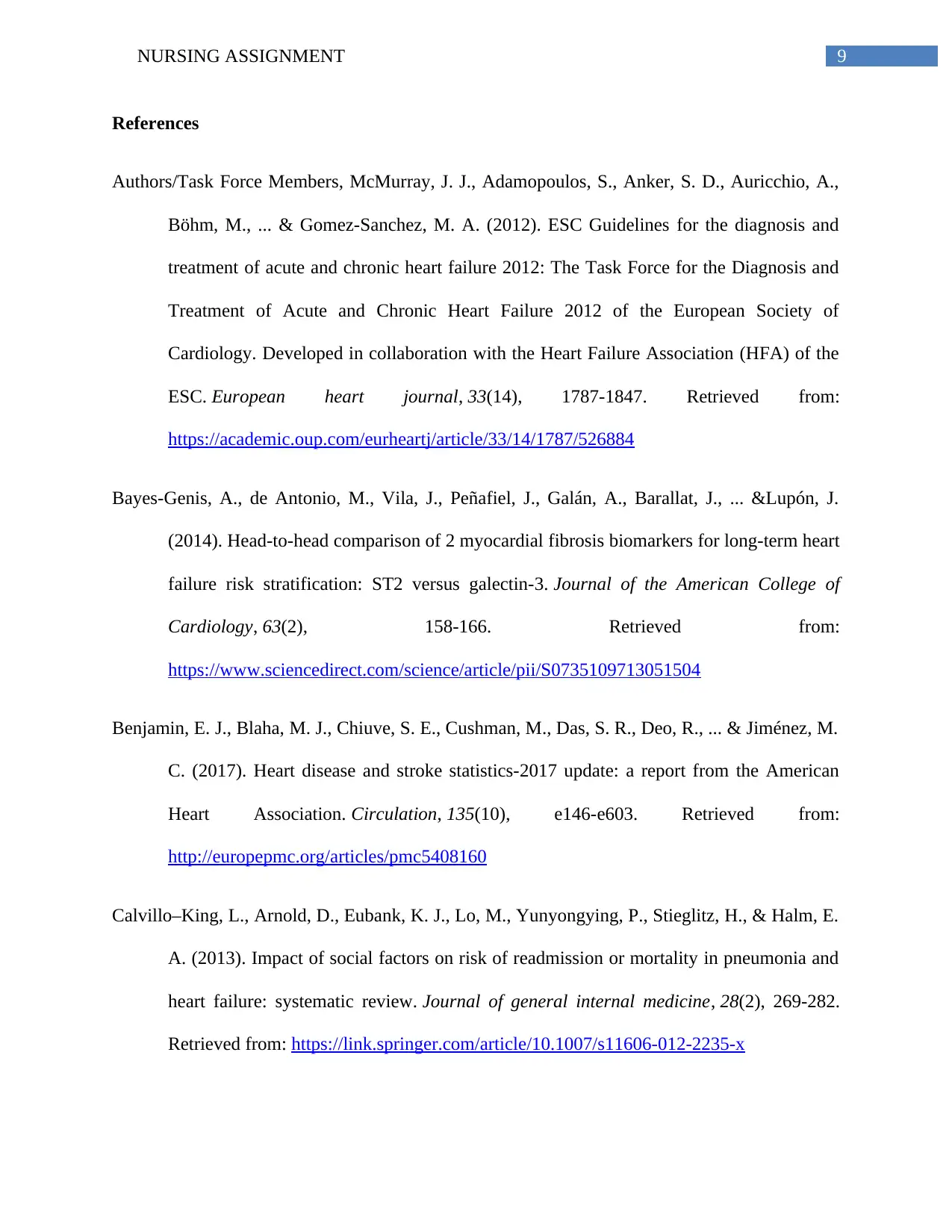
9NURSING ASSIGNMENT
References
Authors/Task Force Members, McMurray, J. J., Adamopoulos, S., Anker, S. D., Auricchio, A.,
Böhm, M., ... & Gomez-Sanchez, M. A. (2012). ESC Guidelines for the diagnosis and
treatment of acute and chronic heart failure 2012: The Task Force for the Diagnosis and
Treatment of Acute and Chronic Heart Failure 2012 of the European Society of
Cardiology. Developed in collaboration with the Heart Failure Association (HFA) of the
ESC. European heart journal, 33(14), 1787-1847. Retrieved from:
https://academic.oup.com/eurheartj/article/33/14/1787/526884
Bayes-Genis, A., de Antonio, M., Vila, J., Peñafiel, J., Galán, A., Barallat, J., ... &Lupón, J.
(2014). Head-to-head comparison of 2 myocardial fibrosis biomarkers for long-term heart
failure risk stratification: ST2 versus galectin-3. Journal of the American College of
Cardiology, 63(2), 158-166. Retrieved from:
https://www.sciencedirect.com/science/article/pii/S0735109713051504
Benjamin, E. J., Blaha, M. J., Chiuve, S. E., Cushman, M., Das, S. R., Deo, R., ... & Jiménez, M.
C. (2017). Heart disease and stroke statistics-2017 update: a report from the American
Heart Association. Circulation, 135(10), e146-e603. Retrieved from:
http://europepmc.org/articles/pmc5408160
Calvillo–King, L., Arnold, D., Eubank, K. J., Lo, M., Yunyongying, P., Stieglitz, H., & Halm, E.
A. (2013). Impact of social factors on risk of readmission or mortality in pneumonia and
heart failure: systematic review. Journal of general internal medicine, 28(2), 269-282.
Retrieved from: https://link.springer.com/article/10.1007/s11606-012-2235-x
References
Authors/Task Force Members, McMurray, J. J., Adamopoulos, S., Anker, S. D., Auricchio, A.,
Böhm, M., ... & Gomez-Sanchez, M. A. (2012). ESC Guidelines for the diagnosis and
treatment of acute and chronic heart failure 2012: The Task Force for the Diagnosis and
Treatment of Acute and Chronic Heart Failure 2012 of the European Society of
Cardiology. Developed in collaboration with the Heart Failure Association (HFA) of the
ESC. European heart journal, 33(14), 1787-1847. Retrieved from:
https://academic.oup.com/eurheartj/article/33/14/1787/526884
Bayes-Genis, A., de Antonio, M., Vila, J., Peñafiel, J., Galán, A., Barallat, J., ... &Lupón, J.
(2014). Head-to-head comparison of 2 myocardial fibrosis biomarkers for long-term heart
failure risk stratification: ST2 versus galectin-3. Journal of the American College of
Cardiology, 63(2), 158-166. Retrieved from:
https://www.sciencedirect.com/science/article/pii/S0735109713051504
Benjamin, E. J., Blaha, M. J., Chiuve, S. E., Cushman, M., Das, S. R., Deo, R., ... & Jiménez, M.
C. (2017). Heart disease and stroke statistics-2017 update: a report from the American
Heart Association. Circulation, 135(10), e146-e603. Retrieved from:
http://europepmc.org/articles/pmc5408160
Calvillo–King, L., Arnold, D., Eubank, K. J., Lo, M., Yunyongying, P., Stieglitz, H., & Halm, E.
A. (2013). Impact of social factors on risk of readmission or mortality in pneumonia and
heart failure: systematic review. Journal of general internal medicine, 28(2), 269-282.
Retrieved from: https://link.springer.com/article/10.1007/s11606-012-2235-x
Secure Best Marks with AI Grader
Need help grading? Try our AI Grader for instant feedback on your assignments.
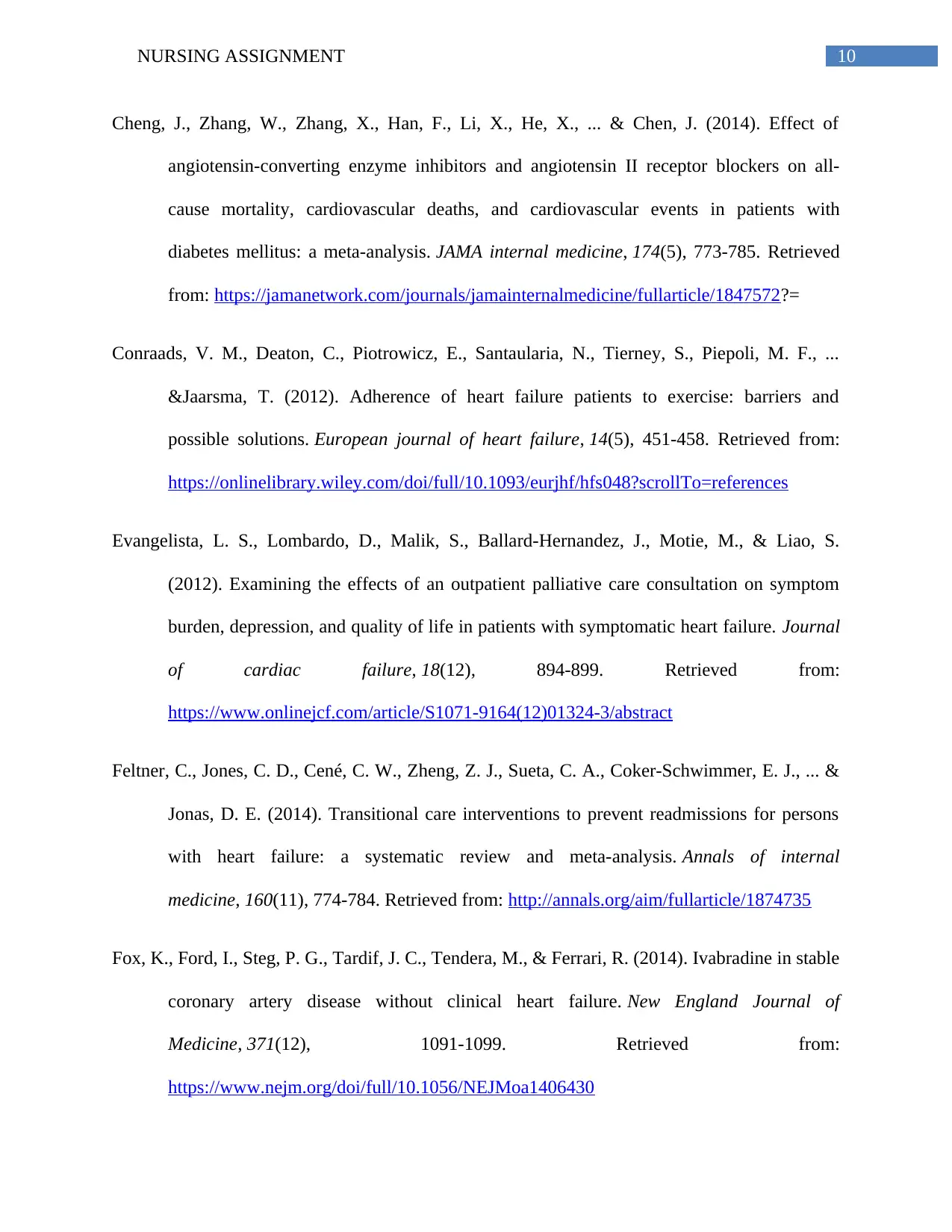
10NURSING ASSIGNMENT
Cheng, J., Zhang, W., Zhang, X., Han, F., Li, X., He, X., ... & Chen, J. (2014). Effect of
angiotensin-converting enzyme inhibitors and angiotensin II receptor blockers on all-
cause mortality, cardiovascular deaths, and cardiovascular events in patients with
diabetes mellitus: a meta-analysis. JAMA internal medicine, 174(5), 773-785. Retrieved
from: https://jamanetwork.com/journals/jamainternalmedicine/fullarticle/1847572?=
Conraads, V. M., Deaton, C., Piotrowicz, E., Santaularia, N., Tierney, S., Piepoli, M. F., ...
&Jaarsma, T. (2012). Adherence of heart failure patients to exercise: barriers and
possible solutions. European journal of heart failure, 14(5), 451-458. Retrieved from:
https://onlinelibrary.wiley.com/doi/full/10.1093/eurjhf/hfs048?scrollTo=references
Evangelista, L. S., Lombardo, D., Malik, S., Ballard-Hernandez, J., Motie, M., & Liao, S.
(2012). Examining the effects of an outpatient palliative care consultation on symptom
burden, depression, and quality of life in patients with symptomatic heart failure. Journal
of cardiac failure, 18(12), 894-899. Retrieved from:
https://www.onlinejcf.com/article/S1071-9164(12)01324-3/abstract
Feltner, C., Jones, C. D., Cené, C. W., Zheng, Z. J., Sueta, C. A., Coker-Schwimmer, E. J., ... &
Jonas, D. E. (2014). Transitional care interventions to prevent readmissions for persons
with heart failure: a systematic review and meta-analysis. Annals of internal
medicine, 160(11), 774-784. Retrieved from: http://annals.org/aim/fullarticle/1874735
Fox, K., Ford, I., Steg, P. G., Tardif, J. C., Tendera, M., & Ferrari, R. (2014). Ivabradine in stable
coronary artery disease without clinical heart failure. New England Journal of
Medicine, 371(12), 1091-1099. Retrieved from:
https://www.nejm.org/doi/full/10.1056/NEJMoa1406430
Cheng, J., Zhang, W., Zhang, X., Han, F., Li, X., He, X., ... & Chen, J. (2014). Effect of
angiotensin-converting enzyme inhibitors and angiotensin II receptor blockers on all-
cause mortality, cardiovascular deaths, and cardiovascular events in patients with
diabetes mellitus: a meta-analysis. JAMA internal medicine, 174(5), 773-785. Retrieved
from: https://jamanetwork.com/journals/jamainternalmedicine/fullarticle/1847572?=
Conraads, V. M., Deaton, C., Piotrowicz, E., Santaularia, N., Tierney, S., Piepoli, M. F., ...
&Jaarsma, T. (2012). Adherence of heart failure patients to exercise: barriers and
possible solutions. European journal of heart failure, 14(5), 451-458. Retrieved from:
https://onlinelibrary.wiley.com/doi/full/10.1093/eurjhf/hfs048?scrollTo=references
Evangelista, L. S., Lombardo, D., Malik, S., Ballard-Hernandez, J., Motie, M., & Liao, S.
(2012). Examining the effects of an outpatient palliative care consultation on symptom
burden, depression, and quality of life in patients with symptomatic heart failure. Journal
of cardiac failure, 18(12), 894-899. Retrieved from:
https://www.onlinejcf.com/article/S1071-9164(12)01324-3/abstract
Feltner, C., Jones, C. D., Cené, C. W., Zheng, Z. J., Sueta, C. A., Coker-Schwimmer, E. J., ... &
Jonas, D. E. (2014). Transitional care interventions to prevent readmissions for persons
with heart failure: a systematic review and meta-analysis. Annals of internal
medicine, 160(11), 774-784. Retrieved from: http://annals.org/aim/fullarticle/1874735
Fox, K., Ford, I., Steg, P. G., Tardif, J. C., Tendera, M., & Ferrari, R. (2014). Ivabradine in stable
coronary artery disease without clinical heart failure. New England Journal of
Medicine, 371(12), 1091-1099. Retrieved from:
https://www.nejm.org/doi/full/10.1056/NEJMoa1406430
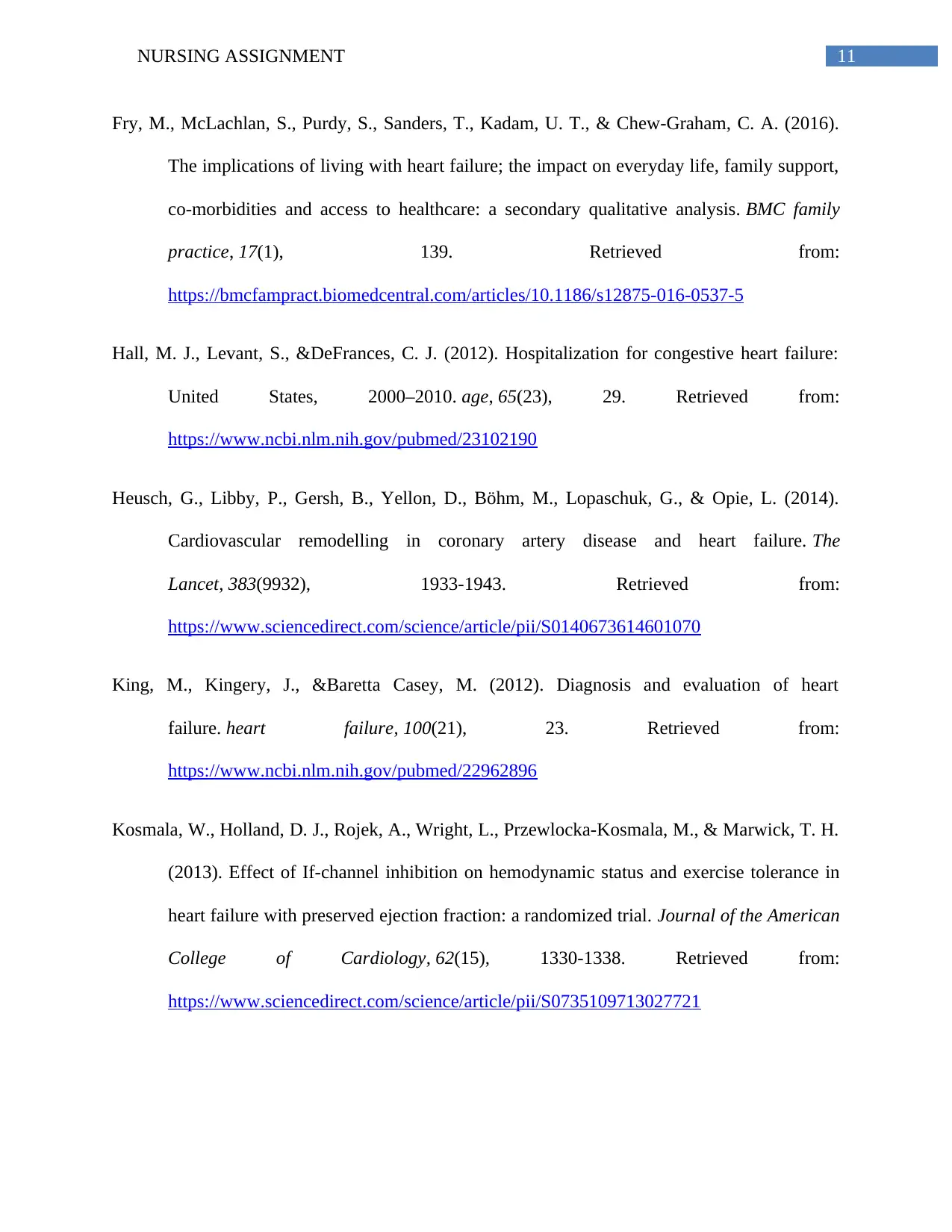
11NURSING ASSIGNMENT
Fry, M., McLachlan, S., Purdy, S., Sanders, T., Kadam, U. T., & Chew-Graham, C. A. (2016).
The implications of living with heart failure; the impact on everyday life, family support,
co-morbidities and access to healthcare: a secondary qualitative analysis. BMC family
practice, 17(1), 139. Retrieved from:
https://bmcfampract.biomedcentral.com/articles/10.1186/s12875-016-0537-5
Hall, M. J., Levant, S., &DeFrances, C. J. (2012). Hospitalization for congestive heart failure:
United States, 2000–2010. age, 65(23), 29. Retrieved from:
https://www.ncbi.nlm.nih.gov/pubmed/23102190
Heusch, G., Libby, P., Gersh, B., Yellon, D., Böhm, M., Lopaschuk, G., & Opie, L. (2014).
Cardiovascular remodelling in coronary artery disease and heart failure. The
Lancet, 383(9932), 1933-1943. Retrieved from:
https://www.sciencedirect.com/science/article/pii/S0140673614601070
King, M., Kingery, J., &Baretta Casey, M. (2012). Diagnosis and evaluation of heart
failure. heart failure, 100(21), 23. Retrieved from:
https://www.ncbi.nlm.nih.gov/pubmed/22962896
Kosmala, W., Holland, D. J., Rojek, A., Wright, L., Przewlocka-Kosmala, M., & Marwick, T. H.
(2013). Effect of If-channel inhibition on hemodynamic status and exercise tolerance in
heart failure with preserved ejection fraction: a randomized trial. Journal of the American
College of Cardiology, 62(15), 1330-1338. Retrieved from:
https://www.sciencedirect.com/science/article/pii/S0735109713027721
Fry, M., McLachlan, S., Purdy, S., Sanders, T., Kadam, U. T., & Chew-Graham, C. A. (2016).
The implications of living with heart failure; the impact on everyday life, family support,
co-morbidities and access to healthcare: a secondary qualitative analysis. BMC family
practice, 17(1), 139. Retrieved from:
https://bmcfampract.biomedcentral.com/articles/10.1186/s12875-016-0537-5
Hall, M. J., Levant, S., &DeFrances, C. J. (2012). Hospitalization for congestive heart failure:
United States, 2000–2010. age, 65(23), 29. Retrieved from:
https://www.ncbi.nlm.nih.gov/pubmed/23102190
Heusch, G., Libby, P., Gersh, B., Yellon, D., Böhm, M., Lopaschuk, G., & Opie, L. (2014).
Cardiovascular remodelling in coronary artery disease and heart failure. The
Lancet, 383(9932), 1933-1943. Retrieved from:
https://www.sciencedirect.com/science/article/pii/S0140673614601070
King, M., Kingery, J., &Baretta Casey, M. (2012). Diagnosis and evaluation of heart
failure. heart failure, 100(21), 23. Retrieved from:
https://www.ncbi.nlm.nih.gov/pubmed/22962896
Kosmala, W., Holland, D. J., Rojek, A., Wright, L., Przewlocka-Kosmala, M., & Marwick, T. H.
(2013). Effect of If-channel inhibition on hemodynamic status and exercise tolerance in
heart failure with preserved ejection fraction: a randomized trial. Journal of the American
College of Cardiology, 62(15), 1330-1338. Retrieved from:
https://www.sciencedirect.com/science/article/pii/S0735109713027721
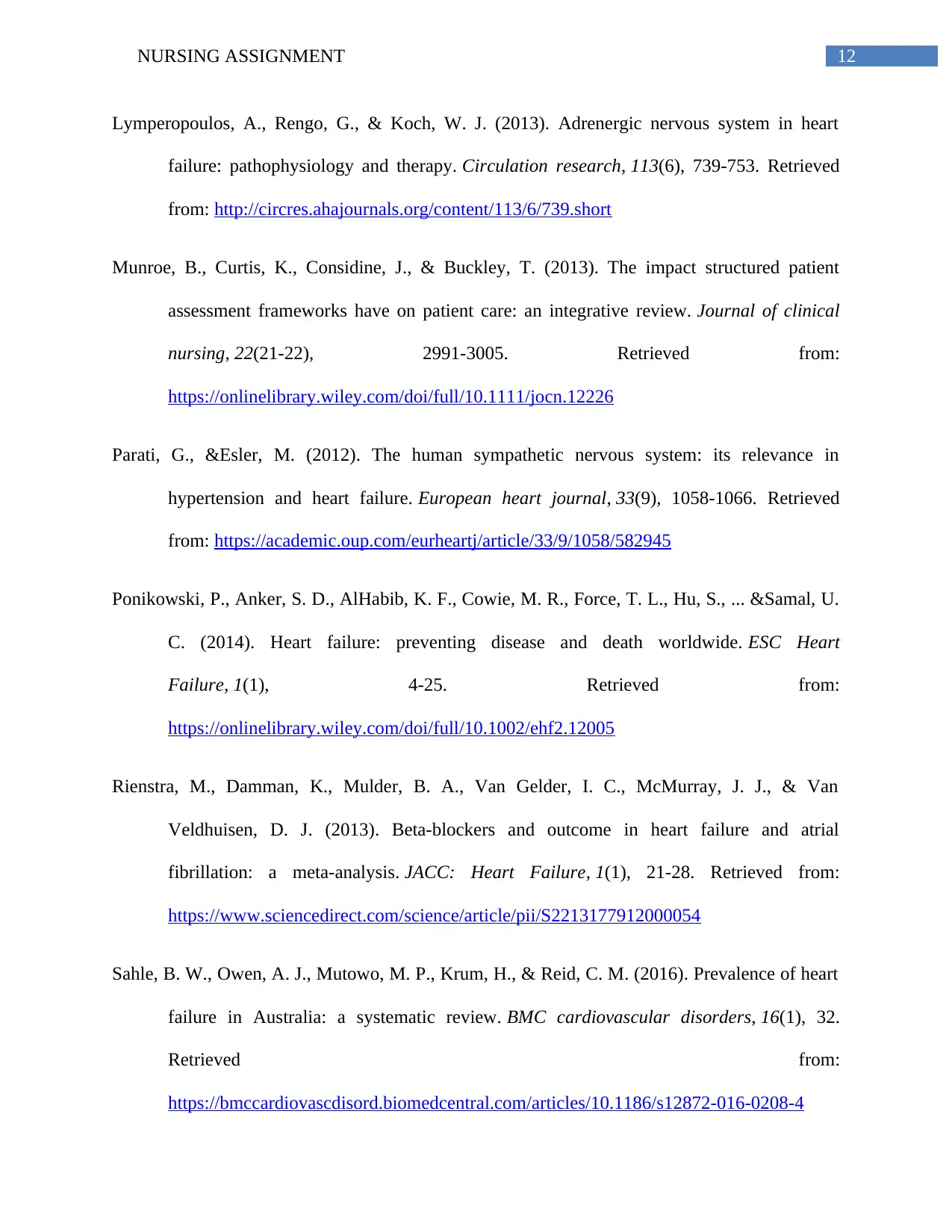
12NURSING ASSIGNMENT
Lymperopoulos, A., Rengo, G., & Koch, W. J. (2013). Adrenergic nervous system in heart
failure: pathophysiology and therapy. Circulation research, 113(6), 739-753. Retrieved
from: http://circres.ahajournals.org/content/113/6/739.short
Munroe, B., Curtis, K., Considine, J., & Buckley, T. (2013). The impact structured patient
assessment frameworks have on patient care: an integrative review. Journal of clinical
nursing, 22(21-22), 2991-3005. Retrieved from:
https://onlinelibrary.wiley.com/doi/full/10.1111/jocn.12226
Parati, G., &Esler, M. (2012). The human sympathetic nervous system: its relevance in
hypertension and heart failure. European heart journal, 33(9), 1058-1066. Retrieved
from: https://academic.oup.com/eurheartj/article/33/9/1058/582945
Ponikowski, P., Anker, S. D., AlHabib, K. F., Cowie, M. R., Force, T. L., Hu, S., ... &Samal, U.
C. (2014). Heart failure: preventing disease and death worldwide. ESC Heart
Failure, 1(1), 4-25. Retrieved from:
https://onlinelibrary.wiley.com/doi/full/10.1002/ehf2.12005
Rienstra, M., Damman, K., Mulder, B. A., Van Gelder, I. C., McMurray, J. J., & Van
Veldhuisen, D. J. (2013). Beta-blockers and outcome in heart failure and atrial
fibrillation: a meta-analysis. JACC: Heart Failure, 1(1), 21-28. Retrieved from:
https://www.sciencedirect.com/science/article/pii/S2213177912000054
Sahle, B. W., Owen, A. J., Mutowo, M. P., Krum, H., & Reid, C. M. (2016). Prevalence of heart
failure in Australia: a systematic review. BMC cardiovascular disorders, 16(1), 32.
Retrieved from:
https://bmccardiovascdisord.biomedcentral.com/articles/10.1186/s12872-016-0208-4
Lymperopoulos, A., Rengo, G., & Koch, W. J. (2013). Adrenergic nervous system in heart
failure: pathophysiology and therapy. Circulation research, 113(6), 739-753. Retrieved
from: http://circres.ahajournals.org/content/113/6/739.short
Munroe, B., Curtis, K., Considine, J., & Buckley, T. (2013). The impact structured patient
assessment frameworks have on patient care: an integrative review. Journal of clinical
nursing, 22(21-22), 2991-3005. Retrieved from:
https://onlinelibrary.wiley.com/doi/full/10.1111/jocn.12226
Parati, G., &Esler, M. (2012). The human sympathetic nervous system: its relevance in
hypertension and heart failure. European heart journal, 33(9), 1058-1066. Retrieved
from: https://academic.oup.com/eurheartj/article/33/9/1058/582945
Ponikowski, P., Anker, S. D., AlHabib, K. F., Cowie, M. R., Force, T. L., Hu, S., ... &Samal, U.
C. (2014). Heart failure: preventing disease and death worldwide. ESC Heart
Failure, 1(1), 4-25. Retrieved from:
https://onlinelibrary.wiley.com/doi/full/10.1002/ehf2.12005
Rienstra, M., Damman, K., Mulder, B. A., Van Gelder, I. C., McMurray, J. J., & Van
Veldhuisen, D. J. (2013). Beta-blockers and outcome in heart failure and atrial
fibrillation: a meta-analysis. JACC: Heart Failure, 1(1), 21-28. Retrieved from:
https://www.sciencedirect.com/science/article/pii/S2213177912000054
Sahle, B. W., Owen, A. J., Mutowo, M. P., Krum, H., & Reid, C. M. (2016). Prevalence of heart
failure in Australia: a systematic review. BMC cardiovascular disorders, 16(1), 32.
Retrieved from:
https://bmccardiovascdisord.biomedcentral.com/articles/10.1186/s12872-016-0208-4
Paraphrase This Document
Need a fresh take? Get an instant paraphrase of this document with our AI Paraphraser
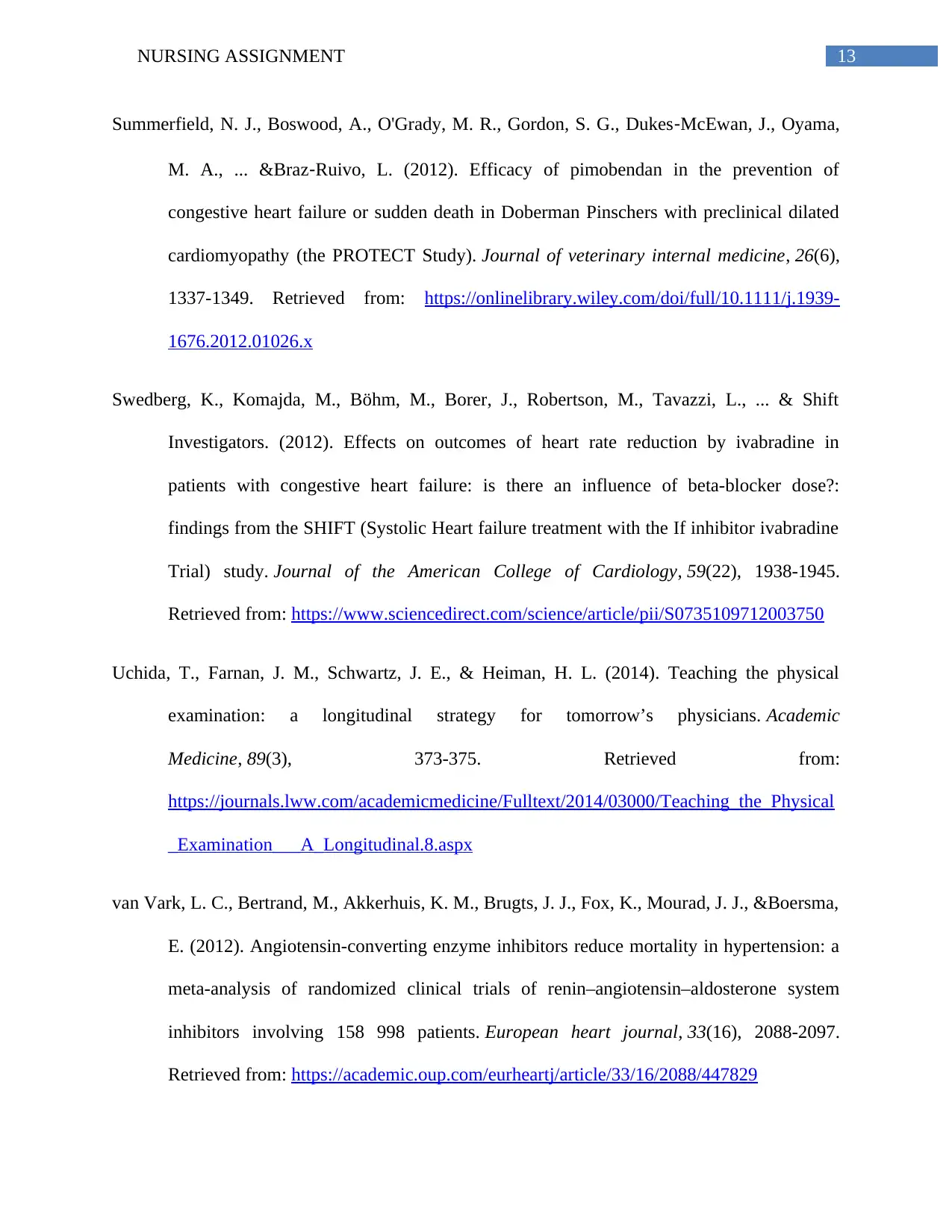
13NURSING ASSIGNMENT
Summerfield, N. J., Boswood, A., O'Grady, M. R., Gordon, S. G., Dukes‐McEwan, J., Oyama,
M. A., ... &Braz‐Ruivo, L. (2012). Efficacy of pimobendan in the prevention of
congestive heart failure or sudden death in Doberman Pinschers with preclinical dilated
cardiomyopathy (the PROTECT Study). Journal of veterinary internal medicine, 26(6),
1337-1349. Retrieved from: https://onlinelibrary.wiley.com/doi/full/10.1111/j.1939-
1676.2012.01026.x
Swedberg, K., Komajda, M., Böhm, M., Borer, J., Robertson, M., Tavazzi, L., ... & Shift
Investigators. (2012). Effects on outcomes of heart rate reduction by ivabradine in
patients with congestive heart failure: is there an influence of beta-blocker dose?:
findings from the SHIFT (Systolic Heart failure treatment with the If inhibitor ivabradine
Trial) study. Journal of the American College of Cardiology, 59(22), 1938-1945.
Retrieved from: https://www.sciencedirect.com/science/article/pii/S0735109712003750
Uchida, T., Farnan, J. M., Schwartz, J. E., & Heiman, H. L. (2014). Teaching the physical
examination: a longitudinal strategy for tomorrow’s physicians. Academic
Medicine, 89(3), 373-375. Retrieved from:
https://journals.lww.com/academicmedicine/Fulltext/2014/03000/Teaching_the_Physical
_Examination___A_Longitudinal.8.aspx
van Vark, L. C., Bertrand, M., Akkerhuis, K. M., Brugts, J. J., Fox, K., Mourad, J. J., &Boersma,
E. (2012). Angiotensin-converting enzyme inhibitors reduce mortality in hypertension: a
meta-analysis of randomized clinical trials of renin–angiotensin–aldosterone system
inhibitors involving 158 998 patients. European heart journal, 33(16), 2088-2097.
Retrieved from: https://academic.oup.com/eurheartj/article/33/16/2088/447829
Summerfield, N. J., Boswood, A., O'Grady, M. R., Gordon, S. G., Dukes‐McEwan, J., Oyama,
M. A., ... &Braz‐Ruivo, L. (2012). Efficacy of pimobendan in the prevention of
congestive heart failure or sudden death in Doberman Pinschers with preclinical dilated
cardiomyopathy (the PROTECT Study). Journal of veterinary internal medicine, 26(6),
1337-1349. Retrieved from: https://onlinelibrary.wiley.com/doi/full/10.1111/j.1939-
1676.2012.01026.x
Swedberg, K., Komajda, M., Böhm, M., Borer, J., Robertson, M., Tavazzi, L., ... & Shift
Investigators. (2012). Effects on outcomes of heart rate reduction by ivabradine in
patients with congestive heart failure: is there an influence of beta-blocker dose?:
findings from the SHIFT (Systolic Heart failure treatment with the If inhibitor ivabradine
Trial) study. Journal of the American College of Cardiology, 59(22), 1938-1945.
Retrieved from: https://www.sciencedirect.com/science/article/pii/S0735109712003750
Uchida, T., Farnan, J. M., Schwartz, J. E., & Heiman, H. L. (2014). Teaching the physical
examination: a longitudinal strategy for tomorrow’s physicians. Academic
Medicine, 89(3), 373-375. Retrieved from:
https://journals.lww.com/academicmedicine/Fulltext/2014/03000/Teaching_the_Physical
_Examination___A_Longitudinal.8.aspx
van Vark, L. C., Bertrand, M., Akkerhuis, K. M., Brugts, J. J., Fox, K., Mourad, J. J., &Boersma,
E. (2012). Angiotensin-converting enzyme inhibitors reduce mortality in hypertension: a
meta-analysis of randomized clinical trials of renin–angiotensin–aldosterone system
inhibitors involving 158 998 patients. European heart journal, 33(16), 2088-2097.
Retrieved from: https://academic.oup.com/eurheartj/article/33/16/2088/447829
1 out of 14
Related Documents
Your All-in-One AI-Powered Toolkit for Academic Success.
+13062052269
info@desklib.com
Available 24*7 on WhatsApp / Email
![[object Object]](/_next/static/media/star-bottom.7253800d.svg)
Unlock your academic potential
© 2024 | Zucol Services PVT LTD | All rights reserved.





